Casavant FAQs
by William A. MacPherson, College Organist

The Wheaton Casavant is a stunning musical instrument and a treasure of the College. It is also a marvelous teaching tool – and not only for those taking organ lessons. I’ve often brought my music history and theory classes to the Chapel. I’ve been a guest lecturer for our course in “The Physics of Music and Sound,” for which the organ provides real-world illustrations of mechanical principles and the mathematics of acoustics. I’ve had the privilege and pleasure of giving talks to community groups and of greeting listeners at the console following organ recitals.
I love demonstrating the organ and taking questions, and share with you here some of the most frequent inquiries. Some might seem basic to organists and aficionados of the instrument, but the answers provide many insights into its design and historical antecedents.
Why are the keyboards reverse-colored?
Let’s start with a question that those looking closely at the console for the first time often ask: Why are the keyboards reverse-colored? I was once even asked “Do you have to play them backwards?” Interpret that as you will – but, no, the ebony naturals and ivory sharps make no difference to the player. The keys feel the same!

The appearance of the keyboards, however, does tell something about the historical style of the instrument. The reverse coloring is meant to evoke the look of organs and harpsichords of the 17th and 18th centuries, that is, the Baroque period.

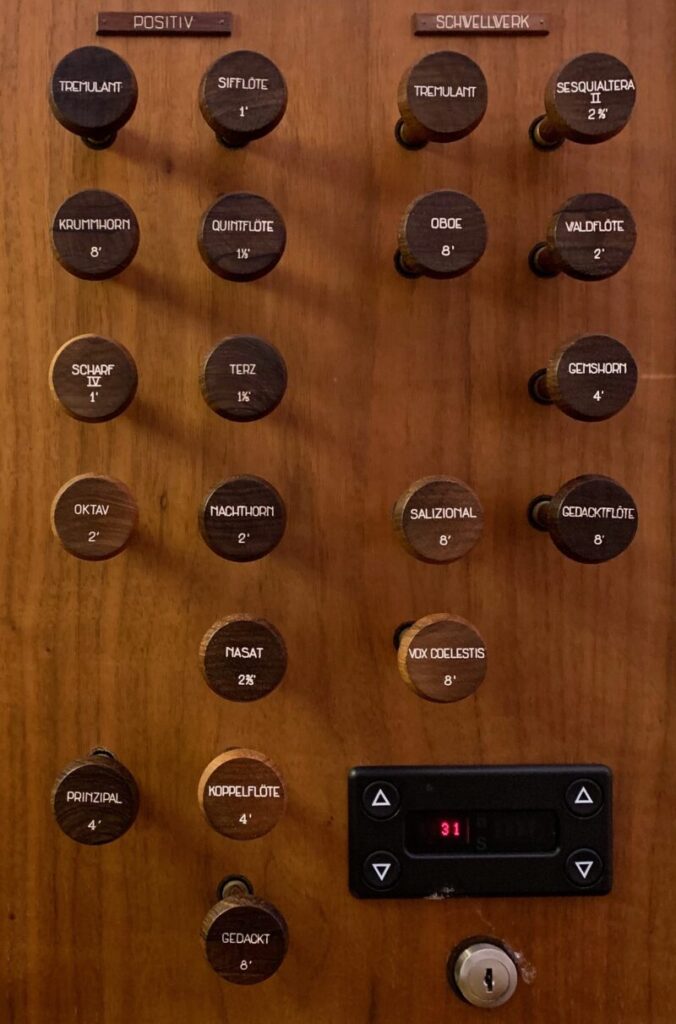
The Germanic names on the stop knobs, such as “Prinzipal,” “Rohrflöte,” and “Trompete,” and the headings above the stops, such as “Hauptwerk” and “Schwellwerk,” indicate, even more specifically, that this organ is in the style of German Baroque instruments.
Why does the organ look like it has always been in the Chapel?
In 2019 the Casavant celebrates its 50th anniversary, but Cole Chapel is a bit more than a century old. The present organ is not the original.
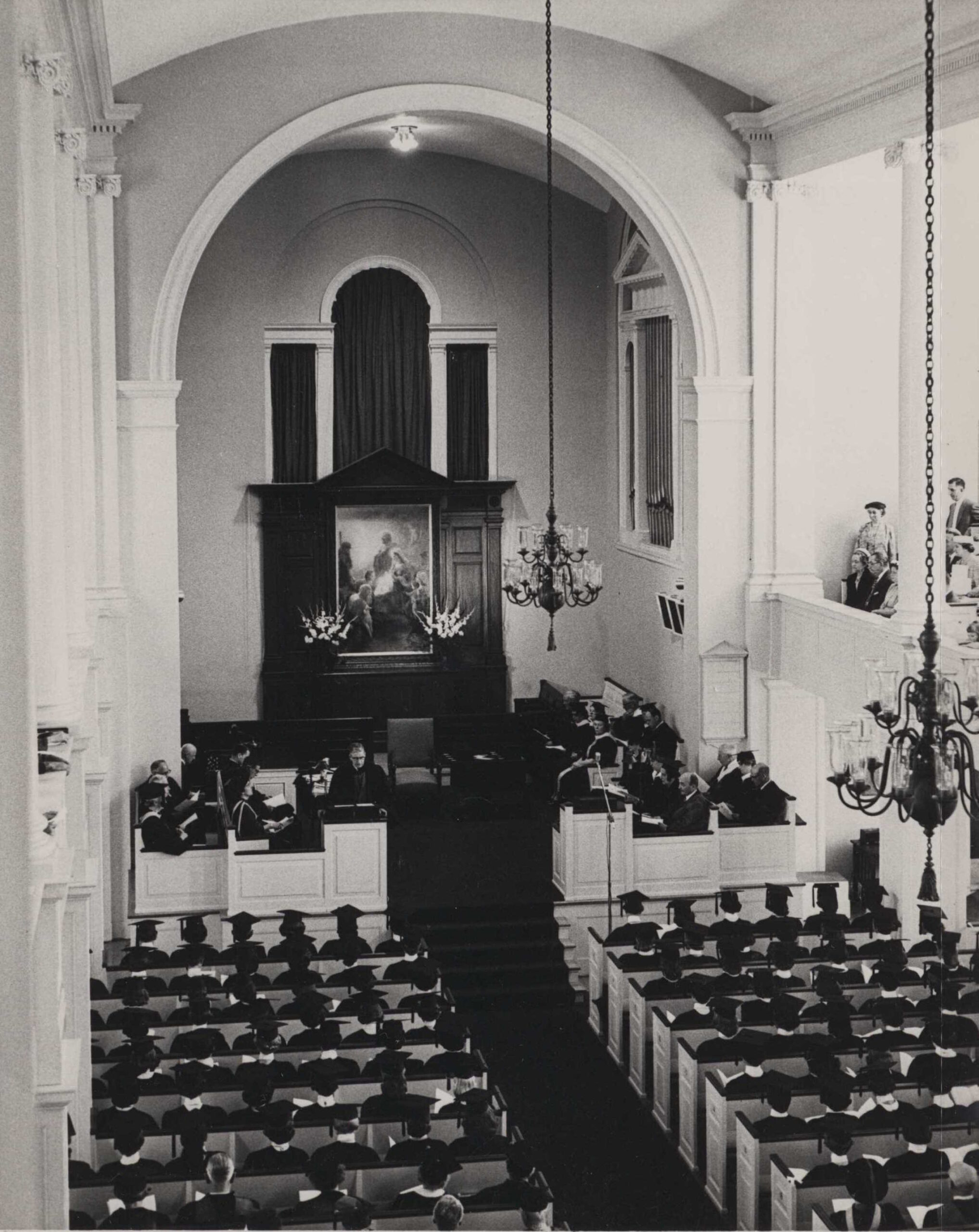
The first instrument, installed when the Chapel was built, was by the renowned Boston firm of Hook & Hastings. The pipes were not visible but hidden in closet-sized chambers high on the side walls of the chancel (the area under the front arch, where the pulpits and altar table were located). The openings were plastered over before the Casavant was installed, but, if you look closely, cracks in the plaster are visible where the chamber openings used to be. The chancel was open all the way to its front wall (the back of the Chapel building). The tripartite Venetian (or Palladian) window that was at the far end of the chancel can still be seen from outside, on Chapel Field, but is now blocked in the interior by the Casavant’s case.
What gives the Casavant its sense of “always being there” is the color and design of the paneling, columns, pediments and other details of the woodworking that match the rest of the Chapel interior. It is also carefully proportioned to fit the available space. Making the case look architecturally elegant required an extraordinary amount of planning and engineering, based on the size and number of pipes and where they were to be positioned. In addition to making drawings, organ builders, especially for large instruments, construct three-dimensional models, both for their own planning and for their clients to approve. Carlton Russell seems quite pleased with this preliminary model, but, with some slight modifications, the end result is even more classically beautiful.
Here’s the final point about the organ case: It embodies one of the principles of the Orgelbewegung. It is relatively shallow, reflecting the organ’s sound directly down the length of the Chapel nave. The pipes are not hidden in chambers on the side, as in the old organ, but are within the actual space in which the organ speaks.
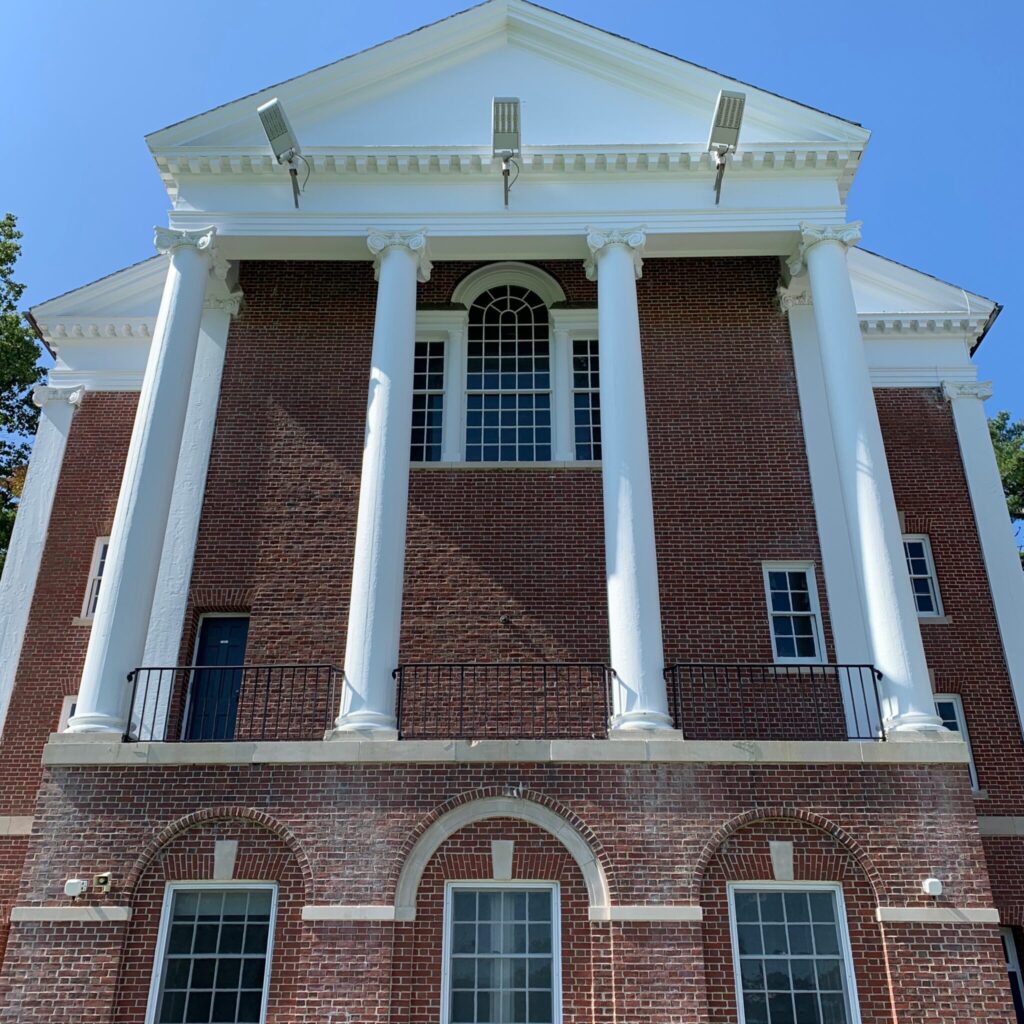

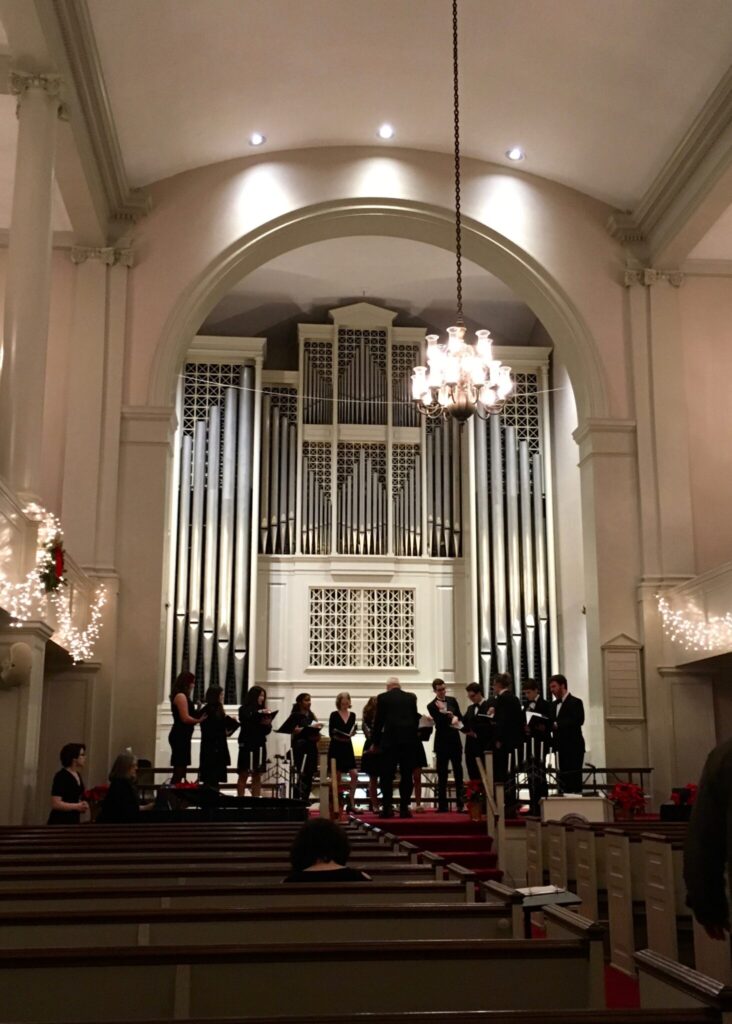
Why are there three keyboards?
Actually, there are four. There are three (called manuals) for the hands, and there’s also the pedalboard, for the feet.

Often the unspoken assumption behind this question is: People only have two hands, so what’s the purpose of the three manuals?
The point of the multiple manuals is more than just where organists place their hands while playing. The hands can go on two different manuals (in any combination of two), or both hands can be on the same manual.
More significantly, the manuals and pedalboard control different divisions of the organ, different groups of stops and pipes, mounted on separate windchests. The latter are large wooden “boxes” that contain pressurized air and also the mechanisms necessary for letting air into the pipes.
The Casavant has four divisions: Pedal (played, obviously, by the pedal keyboard), Positiv (bottom manual), Hauptwerk (middle manual), and Schwellwerk (top manual). Hauptwerk means “main division,” and it includes the organ’s most foundational and loudest sounds. The Positiv is a sort of counterpart to the Hauptwerk, a little lighter in tone, but almost as loud and bright.
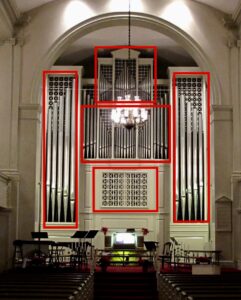
The Schwellwerk contains the organ’s softest and most expressive sounds. The expressivity of this division is enhanced by placing its pipes within a closed chamber that has shades, like vertical venetian blinds, on its front side. These can be opened and closed gradually, to make a smooth crescendo or decrescendo. (Organ pipes themselves cannot be made to sound gradually louder or softer without affecting their pitch).
So, here’s another principle of the Orgelbewegung, as embodied in the Casavant: The divisions are independent of one another. They occupy separate spaces within the case, and those locations are visible on the façade.
The pedal pipes are on two windchests, each of which runs from front to back behind the large pipes in the towers on the left and right. This division includes the lowest sounds of the organ, which require the largest pipes (such as the ten in the façade). The two towers provide not only symmetry in the case design, but also allow the heavy weight of the pedal pipes to be distributed equally on opposite sides of the chancel.
The windchests for the three manual divisions run from side to side between the pedal towers. The enclosure for the Schwellwerk is directly above the console. The Hauptwerk is in the center of the case, and the Positiv is at the top.
The organ has more than 2500 pipes, but I see only several dozen. Where are the rest?
The short answer is: Inside the case, behind the façade pipes, and, more specifically, on the windchests of the four divisions. Most of the 2500 interior pipes are much smaller (and, therefore, higher pitched) than the ones in the façade.

Why are there so many pipes, and how do the numbers add up so quickly? Here’s an example, based on the Hauptwerk. This photo shows the stop knobs on the console that control the pipes of this division:
The manuals have 56 keys. Each stop knob controls a set of 56 pipes, one pipe for each key. (One set of pipes, with its own particular tone color, is called a rank). Exceptions are the two stops on the top left, “Mixtur,” and “Scharf,” marked with the Roman numeral “IV.” For these stops, pressing one key activates four separate pipes (all of them quite small and high in pitch). So, total it up. Count the stop knobs (ignore the one at the bottom marked “Positiv to Hauptwerk), multiply by 56, and then add in the extra three ranks of 56 in both the “Mixtur” and the “Scharf.” The answer to this math problem is 952 – the number of pipes in just this one division.
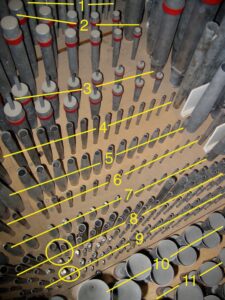
This photo shows the central portion of the Hauptwerk windchest, where the smallest pipes of each stop are located (the rows continue off to either side). You can see the various ranks of pipes lined up in rows.
These 11 rows of pipes are controlled by the following stop knobs: (1) Prinzipal 8’ (the pipes shown in this photo are directly behind the Hauptwerk façade pipes, which also belong to this stop); (2) Quintaden 16’; (3) Rohrflöte 8’; (4) Oktav 4’; (5) Spitzflöte 4’; (6) Oktav 2’; (7) Blockflöte 2’; (8) Mixtur IV (one group of 4 pipes, corresponding to one key, is circled); (9) Scharf IV (again, one group of 4 pipes is circled); (10) Fagott 16’; (11) Trompete 8’.
The 11 sets of pipes all sound different from one another. For one thing, they represent different types of organ tone: Principle (typical, foundational organ color, e.g. the Prinzipal 8’), Flute (such as the Rohrflöte 8’), and Reed (such as the Fagott [Bassoon] 16’ and Trompete 8’). A particular color is determined by the shape, construction, and proportion of the pipe. Secondly, they speak in different octave ranges, designated by an Arabic numeral. 8’ indicates normal pitch, 4’ means the whole rank speaks an octave higher, 2’ yet another octave higher, and 16’ an octave lower than normal pitch.
To summarize, within the 11 sets of pipes in the Hauptwerk division (numbering 952 pipes in total) there are several different tonal colors and several different octave ranges. Look at the specification of the entire organ – the stop list for all four divisions. Every division contains stops of different tone colors and stops in different octave ranges. This is the embodiment of the Orgelbewegung principle of several independent, equally important “mini-organs” within the one large instrument. Each keyboard plays one of these “mini-organs,” i.e., divisions.
How does it all work?
We have one more important principle of the Orgelbewegung to cover and that’s the preference for direct mechanical connection between the keys and the pipes. The key action in Wheaton’s Casavant is mechanical.
When the player presses a manual or pedal key, the opposite end lifts a connecting wire or thin metal rod. This action is transmitted by other wires and rods, as well as thin wooden strips, called trackers. (Hence, mechanical action is often called tracker action). Here’s what the back of the console looks like:

The rods at the top of the photo go from the backs of the Schwellwerk keys upwards, towards its windchest. The rods and wires at the bottom of the photo are attached to the keys of the lower two manuals, the Hauptwerk and the Positiv. They continue downwards towards the floor of the organ chamber. There the action is turned 90 degrees, towards the rear of the chamber. Then it is turned 90 degrees again, upwards via trackers towards the windchests of these two divisions. Recall that the Positiv division is at the top of the case, so the total length of its action is around 30 feet from key to windchest. Careful engineering makes it amazingly light and responsive.
Once the rods and trackers reach the bottoms of their respective windchests, they connect with wires that pull down and open valves (called pallets) that let air into the pipes. The trackers in this photo connect with the pallet wires coming out of the bottom of the Schwellwerk windchest.
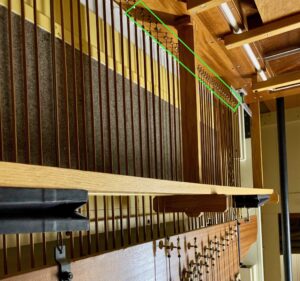
The pallets allow air to flow into wind channels that run from front to back within the windchests. There is one wind channel for each pitch on the keyboard. Here’s the Hauptwerk windchest again. The dotted lines indicate the position of three (of the 56) wind channels within the chest, corresponding to the highest D#, E, and F on the Hauptwerk manual.
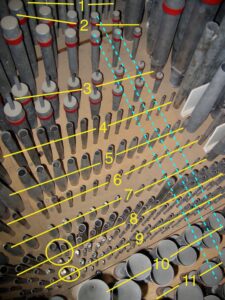
One last problem to solve: How do the stop knobs control particular ranks of pipes? If there were no way to do this, the air in the wind channel of, say, the highest F would cause the highest F pipes in all the ranks to sound.
This is the function of the stop action (as opposed to the key action). On the Wheaton Casavant it is operated electrically. Below each rank of pipes and above the wind channels is a long wooden strip, called a slider, running from one end of the windchest to the other. The slider has 56 holes in it, matching the position of the feet of the 56 pipes in the rank. When the slider is positioned so that its holes match the holes that the pipes sit in, then air can flow into this rank. When the slider is pulled slightly to the side, the holes won’t match up, and air is prevented from flowing into the rank.
Pulling out a stop knob on the console activates an electric switch, which sends current to a solenoid motor. The motor pulls on the slider to move it into the open position. Turning off the stop moves the slider to the closed position. Here are some slider motors in the Pedal division:
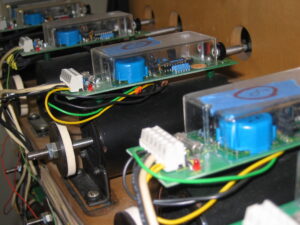
Before electric power was available, both key action and stop action had to be mechanical. So, for instance, in the time of Bach, “pulling out the stops” meant really pulling them out – a long way – because that heavy mechanical action had to be transmitted to the sliders.
Large, modern organs (such as the Wheaton organ) that are influenced by the organ reform movement retain the mechanical key action, because the player can actually feel it in the fingers, and it allows sensitive, responsive touch. The stop action is not felt at all by the player; it’s simply a way to turn stops on and off. So, as in the Wheaton Casavant, stop action is often electrified. Electric stop action also permits the inclusion of a combination action by which the player can preset various stop combinations. Read about the combination action on the Wheaton organ here.